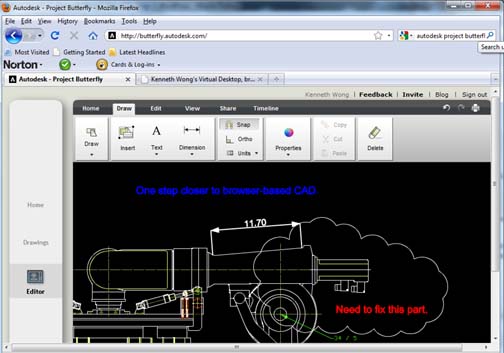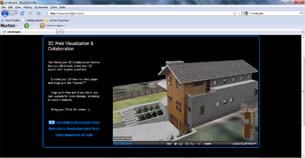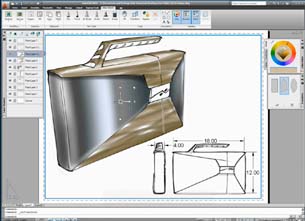February 1, 2010
By Kenneth Wong
January has been a busy month for Autodesk. As though making up for news shortage during Autodesk University 2009, the company previewed two technologies back to back: Autodesk Project Butterfly and Autodesk Alias Sketch for AutoCAD, both available now for test driving at Autodesk Labs. Whereas Butterfly advances Autodesk’s vision for browser-based CAD, Alias Sketch adds zest to the revered granddaddy of 2D CAD. Each gives us some insight into how the company plans to reinvent itself for the next wave.
CaaS (CAD as a Service)
Butterfly falls into the specie of applications commonly known as software as a service (SaaS). No installation, no download—all you need to use Butterfly is a standard browser. Like its older cousin Project Twitch (older only by a few months), Butterfly lets you run remote software loaded with basic 2D drafting, drawing, markup, and annotation features right from a browser.
Project Twitch, which lets you remotely run Autodesk’s famous 3D tittles (most notably, Autodesk Inventor and Autodesk Revit) in a similar fashion, has more stringent requirements. At launch time, you couldn’t run Twitch unless you were located within 1,000 miles from Autodesk’s data center in California. Though this proximity limitation has been removed, other requirements remain. For example, you need a broadband connection (5MB per sec), along with 1GB RAM and 1.6GHz CPU horsepower. In addition, you’re limited to working with preloaded CAD files, without being able to save your online work to your own hard drive.
Butterfly, on the other hand, lets you upload your own DWG files to the remote folder, then save the modified work back to your local drive. The application has little or no restrictions, presumably because processing 2D DWG files over the Internet is easier than doing the same with 3D files. Even so, Butterfly exhibits noticeable latency in operations like Mirror or Scale. With simpler commands like Copy or Move, the delay is less evident. In other words, the software’s response to your mouse click or menu selection is not instantaneous, but the delay is at an acceptable level.
 Fig 1. Autodesk adds Project Butterfly, another browser-based CAD technology, to complement Project Twitch, already in Autodesk Labs. |
A survey that Autodesk conducted in April 2009 suggests the company is doing preliminary works to make AutoCAD available on Mac, a platform long forsaken by CAD developers. But SaaS, or browser-based CAD, could provide Mac-compatibility indirectly. SaaS solutions are not tied to the operating system on the user’s machine, so you can use Twitch or Butterfly straight from a Mac.
Land Grab in the Cloud
Another player eyeing the silver lining in cloud computing is AfterCAD, which develops and markets the browser-based visualization and collaboration application Renderjam.
“All of our technologies have been boiled down into a single platform called LiveWeb,” explained Chris Boothroyd, CEO of AfterCAD. “LiveWeb is actually all the stuff that Renderjam sits on. There has been a tremendous amount of R&D and new 2nd Generation 3D streaming technology put into LiveWeb.”
 Fig 2. AfterCAD’s Renderjam promises browser-based 3D collaboration and rendering. |
This week, AfterCAD struck a partnership with Open Design Alliance (ODA) to “to expose core technical graphics solutions and tools that handle complex visual elements to the streamlining of Software as a Service (SaaS) technology” (ODA’s announcement to the press). We may soon expect the two to jointly develop and showcase prototype technologies.
According to AfterCAD’s online literature on LiveWeb, the platform may be used to host web-based applications for 2D collaboration, 3D collaboration, CAD file conversion, and more.
AutoCAD, Not Just for Drafting
Autodesk’s flagship product AutoCAD suffers from what Hollywood actors refer to as typecasting. Despite the addition of 3D modeling tools, people continue to regard it as a 2D package. During Autodesk University 2009, the company’s senior VP Amar Hanspal joined his colleague Marc Petit to demonstrate AutoCAD’s 3D morphing and editing tools in the Media and Entertainment keynote.
Alias Sketch is the preview of what might become an AutoCAD plug-in. Whereas AutoCAD is used primarily for drawing geometric shapes (basically, lines and arcs) in precision, Alias is designed for the quick, creative, playful, experimental sketching commonly needed in the conceptualization phase.
 Fig 3. Alias Sketch for AutoCAD adds image editing and manipulation tools to the company’s classic drafting program. |
Once downloaded and installed, Alias Sketch for AutoCAD gives you direct access to many of the sketching, composition, and image manipulation tools from Alias right from AutoCAD. The ability to morph and deform existing designs, isolate and crop 2D images, and overlay them on top of each other transforms AutoCAD into an image editor.
Often, to produce impressive presentation materials, AutoCAD users may export their designs into a raster-editing program such as Adobe Photoshop. The Alias Sketch plug-in for AutoCAD addresses this workflow with ease and economy (standalone copy of Photoshop costs anywhere from $299 to $999).
Reengineering Technology and Culture
At last count, Autodesk Labs hosts nearly half dozen browser-based solutions: Project Freewheel, Project Showroom, Project Dragonfly, Project Butterfly, and Project Twitch, to name but a few. Furthermore, with 3D mesh editing and image editing, the version of AutoCAD emerging in the next few years may be unrecognizable to veterans who once swore by AutoCAD R14. These efforts give us a glimpse of Autodesk’s undertaking—reengineering itself and its technologies to prepare for the culture shift in CAD.
Subscribe to our FREE magazine, FREE email newsletters or both!
About the Author
Kenneth Wong is Digital Engineering’s resident blogger and senior editor. Email him at [email protected] or share your thoughts on this article at digitaleng.news/facebook.
Follow DE





